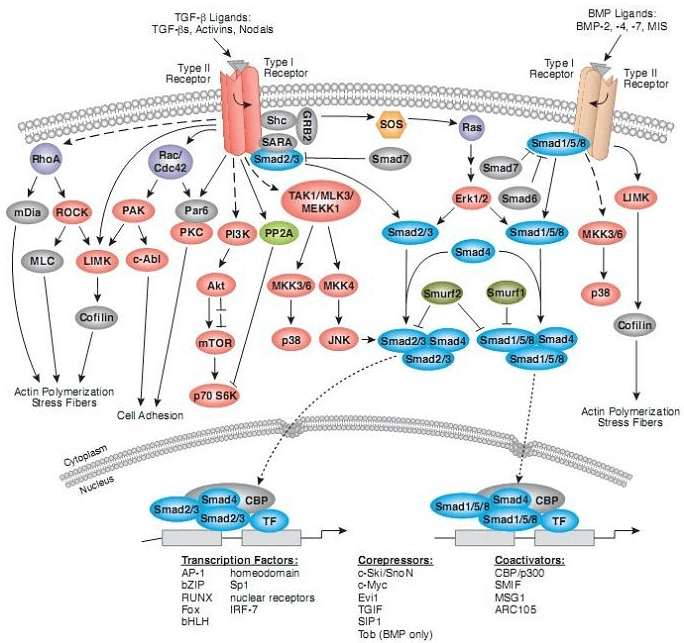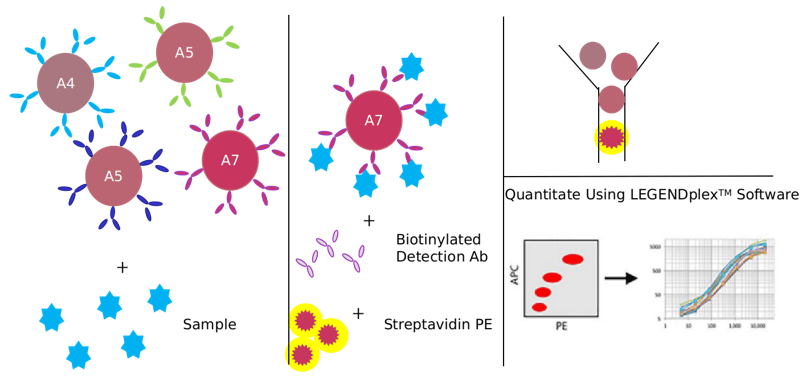Introduction to SMAD signaling pathway
Based on Luminex technology platform, Creative Proteomics provides analysis services for key targets of SMAD signaling pathway.

Smad (abbreviated from Sma in nematodes and Mad in Drosophila) protein is a signal transduction molecule downstream of TGF-β family receptors. There are at least 9 smad proteins currently found in vertebrates, namely:
(a) Receptor-regulated Smads (R-Smads): Smad 1, Smad 2, Smad 3, Smad 5, and Smad 8;
(b) Co-regulate Smads: Smad 4 and Smad 10;
(C) Inhibitory Smads (I-Smads): Smad 6 and Smad 7.
Smad 2, and Smad 3 participate in the TGF-β and activin signaling pathway, while Smad 1, Smad 5 and Smad 8 regulate the BMP signaling pathway. R-Smads and Smad 4 are mainly located in the cytoplasm, and their activity is mainly regulated by adaptor proteins, such as Smad anchored receptor activator protein (SARA) and ELF. Smad 2 and Smad 3 are directly phosphorylated by TGF-β RI, which changes the conformation and releases them from the receptor complex. The MH2 domain of Smad 4 protein recognizes the phosphoserine at the C-terminus of R-Smads to form a heterodimer complex (R-Smad/C-Smad). These complexes are transported to the nucleus, where the Smad protein binds to homologous DNA and has low adsorption capacity, but it can enhance the affinity under the action of transcription co-activators. Smad 3 and Smad 4 bind to a DNA sequence called SBE, and Smad 2 reacts with the DNA complex through interaction with Smad 4. The shuttle of Smad protein's dependent phosphorylation between the cytoplasm and the nucleus is of great significance for the dynamic regulation of TGF-β signaling.
The Smad signaling pathway is the main conduction pathway of TGF-B, and its transduction process requires precise regulation of its components. Smads protein is an important signal molecule for TGF-B ligand transduction from the receptor to the nucleus to perform fibrogenic function. It mainly includes: receptor-activated Smad (receptor-activated Smad, R-Smad), such as Smad2 and Smad3; general Type Smad (common Smad, Co-Smad), such as Smad4; inhibitory Smad (inhibitorySmad, I-Smad), such as Smad6 and Smad79-0. In addition, factors that inhibit the TGFB signal transduction pathway include transcriptional co-repressor c-Ski and its related protein SnoN located in the nucleus.
Our detectable targets:
| AKT | BID | IAPs | tBID | SODD | Bad |
| MLC | Bax | PIDD | MYD88 | Rac1 | TLR4 |
| PAK | RIP1 | Par6 | FADD | APAF-1 | MKK3 |
| ROCK | IRF7 | Erk2 | NFκB | RIG-1 | TRAF3 |
| LIMK | IRF9 | MEKK1 | p38 | RIP1 | TRAF5 |
| mTOR | IRS1 | MEK6 | p50 | SLP76 | TRAM |
| FTO | IRS2 | MSK1 | p65 |
Technology platform:
We provide Luminex technology for SMAD signaling pathway analysis.
Luminex technology is a multifunctional liquid phase analysis platform developed on the basis of colored microspheres, laser technology, applied fluidics and high-speed digital signal processing technology. The core is to encode polypropylene microspheres or magnetic microspheres with fluorescent dyes. By adjusting the different ratios of the two fluorescent dyes, up to 100 microspheres with different fluorescence spectra can be obtained. Antigen-antibody, enzyme-substrate, ligand-receptor binding reactions and nucleic acid hybridization reactions are performed on microspheres with different fluorescence encoding. Qualitative and quantitative analysis by laser detection of microsphere coding and reporter fluorescence separately.
Smad works with general transcription factor (GTF), other transcription factors or accessory proteins to regulate target gene transcription. z It is widely used in various tumor detection, chondrocyte differentiation, bone development, cartilage formation, and bone formation.
In addition to Luminex Multiplex Assay, Enzyme-linked immunosorbent assay (ELISA), Flow cytometry (FACS analysis) technology can also be provided to meet other customer needs.
Advantages of SMAD signaling pathway detection:
- High-throughput and high-speed: Each microsphere is used as a separate test body, which can perform a large number of biological tests at the same time. It only needs 10~201 samples to test up to 100 indicators at a time, and the fastest can reach 10,000 tests /hour.
- Good repeatability: The Luminex detection platform directly reads the fluorescence value, which is more stable and sensitive: 100 microspheres of each type are detected, and the median value is taken as the result, which is equivalent to 100 repeated detections for each sample.
- Low cost: Simultaneous detection of multiple indicators of a sample can save time, samples, reduce detection costs, and improve analysis efficiency.

Application of our service:
- To study the regulation mechanism of SMAD signal pathway in disease
- To study the effect of each virus on SMAD signaling pathway
- To study the effects of drugs or therapies on SMAD signaling pathways
Creative Proteomics has developed a signal pathway target detection platform. We are not limited to providing SMAD signal path detection services, but can also provide other signal path detection services. If you want to detect other targets, please contact us and we will customize the service for you. Look forward to working with you.
Reference:
- Mizuno, K., Nakane, A., Nishio, H. et al. Involvement of the bone morphogenic protein/SMAD signaling pathway in the etiology of congenital anomalies of the kidney and urinary tract accompanied by cryptorchidism. BMC Urol, 2017, 17(112).



